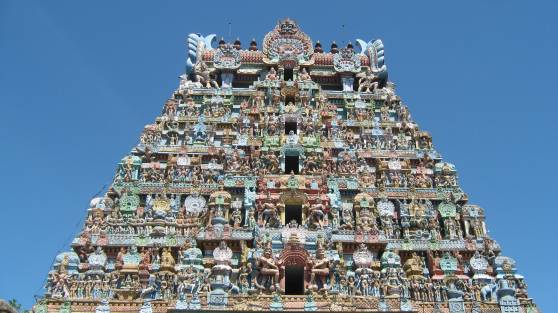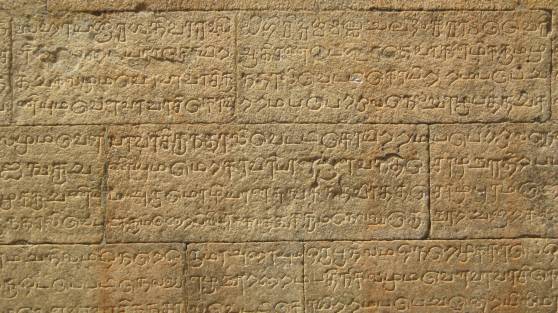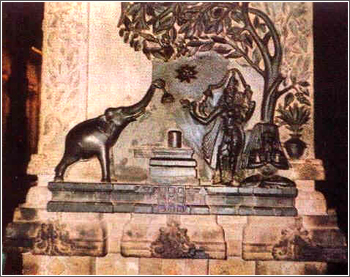On my recent visit to India, I was fortunate to visit some of the ancient temples in Tamil Nadu. Even before I started my travel, I was very excited at the prospect of visiting temple towns rich in cultural legacy. To me, it brought back childhood memories of visiting the Kabālīśvarar Temple in Mylapore along with my father, who would keep chanting “Nāgēndra Hārāya” as we went around the temple in the morning. As a performing musician I had plenty of opportunities to visit different cities in India. My sight seeing always consisted of a visit to the local temples. Whether it is Bangalore or Pune or Calcutta or you name the city, I always enjoy visiting temples.
Though my visit to Madras (ugh… Chennai) was quite short I still managed to visit some beautiful temples down south. It is also a beautiful experience since I always associate the temple with a Kriti composed by the great Vāggeyakkāra-s of Karnāṭaka Sangītam. As I was going round the Jambukēsvarar – Akilānḍēśvari Temple at Tiruvānaikāval, Trichy I was singing to myself Dikśitar’s Akilānḍēśvari in Jujāvanti. It is one of the masterpieces of Dikśitar and every time that I hear this kriti, I am transported to a different world ☺. Before I write about the composition, let me give a few details about this Kśētram.

Tiruvānaikkāval also known as Gajāraṇyam, Jambukēśvaram, Jñānēndram and Amudēśvaram, is one of the Panca Bhūta Sthalam-s and is referred to as Appusthalam since Lord Śiva as Jambukēśvara is regarded as an embodiment of the element water. In fact in the shrine of Jambukēśvarar, one can see that the liṅgam is perpetually surrounded by water known as the Srimath Tīrtham. The priest told me that when the river Kāveri is flooded, the entire prakāram would also be flooded.
The Lord in this Kśētram is known as Jambukēśvarar and Sambhunāyagar. The Goddess is known as Akilāṇḍēśvari and Akilāṇḍānāyagi. This is a Pāḍal Petra Sthalam and pathikam-s have been sung by Appar, Sundarar and Sambandar.

Legend – 1
There are many legends associated with this temple. According to one such legend, this Kśētra was once upon a time a forest of Jambu trees. Two devotees of Lord Śiva, were born as an elephant and spider on account of a curse. Everyday the elephant would worship Lord Śiva by bringing water, flowers and fruit in its trunk from the forest. In the nearby Nāval tree, there lived a spider, which served the Lord by spinning a web above the Liṅgam to shelter Him from dust and dry leaves. The elephant on seeing the web, would destroy it, since it considered the web to be impure. One day the elephant came to offer worship even as the spider was spinning its web. Enraged, the elephant destroyed the web. This angered the spider, which entered the trunk of the elephant and caused its death by injecting its venom. The spider also died, since it could not find its way out of the elephant’s trunk. But on account of the good merit that they had accrued by worshipping Lord Śiva, the elephant went to Śivalōka where it became the leader of the Gaṇā-s. Meanwhile the spider was born as Cōḷā King Ko Chenkōt Cōḷā. On account of this legend, this Kśētram came to be known as Nāvarkā Ānaikā, Gajāraṇyam in Sanskrit and Tiruvānaika in Tamizh.
Legend – 2
Once there lived a sage called Jambu Mādhavan, who did penance in a forest. One day a white Nāval fruit fell on his lap. He took this fruit to Mount Kailāśa and offered it to Lord Śiva. Moved by the affection of his devotee, the Lord ate the fruit and spit out the seed. The sage regarded the seed as the prasādam of the Lord and ate it. This took root in the stomach of the sage and grew as a huge Nāval Tree. The Lord blessed the sage and asked him to go to a Nāval forest near the river Ponni, where the Lord promised to manifest as a Liṅgam beneath this tree. As promised Lord Śiva appeared beneath this tree, which is the Sthala Vṛikśam in this temple. Hence this Kśētra came to be known as Jambukēśvaram.
Legend – 3
Initially Goddess Akilāṇḍēśvari was an ugra dēvata. The credit for transforming her into a Śanthasvarūpini goes to Ādi Śaṅkarā. He adorned her with ear – rings known as tāḍaṅgam bearing the symbol of the Śri Chakram. He transferred her fierce power into the tāḍaṅgam-s. He also installed Prasanna Vināyagar, facing Goddess Akilāṇḍēśvari, which is instrumental in transforming her into a benevolent deity. Maha Periva, Sri Chandrasēkara Sarasvati, the Pontiff of Kañci Kāmakōṭi Pīṭham, renewed that tāḍaṅgam-s in 1980s.
Legend – 4
Once Goddess Pārvati mocked at Lord Śiva’s penance for betterment of the world. Enraged by her act, Lord Śiva directed her to go to the earth and perform penance there. The Goddess found a ‘Jambu’ forest at Tiruvānaika or Tiruvānaikoil to commence her penance. She made a Liṅgam from the waters of the River Kāveri also known as Ponni. She performed her penance under the ‘Venn Nāval’ tree (the tree from the sage Jambu). So, the Liṅgam is known as ‘Appu Liṅgam’ (Appu-Water).

Lord Śiva appeared before Goddess Akilāṇḍēśvari and bestowed on her Śiva Gñanam. The Goddess took ‘Upadēśa’ (lessons) facing east while the Lord faced west. Hence the deities in the temple are also installed in the same direction. Such places are known as ‘Upadēśa Sthalam-s’. Since the Lord was the Guru and the Goddess was his Siśya, the ‘Tiru Kalyaṇam’ (marriage) is not conducted in this temple.

Since Goddess Akilāṇḍēśvari worshipped Lord Śiva in this temple, at noon the ‘Archakar’ (priest) dresses like a female and performs pūja to Lord Śiva and ‘Gō Mātha’ (Cow) every day.

Such a legendary Kśētram has been immortalized in the kṛiti-s of Śri Muthusvāmi Dīkśitar. Dīkśitar has sung Jambupatē in rāgā Yamunākalyāni – tiśra ēkam in praise of Lord Jambukēśvarar (it is one of the Pañca Bhūta Kśētra Kriti-s) and Akilāṇḍēśvari in rāga Jujāvanti – ādi tāḷam in praise of Goddess Akilānḍēśvari. It is notable that he has used hindustāni rāgā-s for both compositions.

Akhilānḍēśvari rakśa mām
Rāgam: Jujāvanti Tāḷam: Ādi
Vāgeyyakkāra: Śri Muttusvāmi Dikśitar
Pallavi
Akhilānḍēśvari rakśa mām
Āgama sampradāya nipuṇē śri
O Akhilānḍēśvari protect me!
One who is an expert in the tradition of the Āgamā-s.
Anupallavi
Nikila lōka nityātmikē vimalē
Nirmalē śyāmaḷē sakala kalē
The one who is the eternal life-force of the worlds. The one who is immaculate.
The one who is a dark. The one who encompasses all the arts.
Caraṇam
Lambōdara guru guha pūjitē
Lambālakōdbhāsitē hasitē
Vāgdēvatārāditē varadē
Vara śaila rāja nutē śāradē
Madhyamakāla Sāhityam
Jambhāri sambhāvitē janārdana nutē jujāvanti rāga nutē
Jhalli maddaḷa jarjhara vādya nāda muditē jñāna pradē
The one who is worshipped by Gaṇēśā and Śanmukhā.
The one who has long locks of hair on her forehead. The one with a smiling face.
The one who is worshipped by the Vākdēvatā-s and is a bestower of boons.
The one who is worshipped by the king of mountains, O Śāradā.
The one respected by Indrā, who is the enemy of the demon Jambhā. The one worshipped by Viṣṇu. The one praised by the Rāgā Jujāvanti.
The one who is pleased by the sound of the musical instruments such as Jalli, Maddaḷa and Jarjhara. The one who bestows Knowledge.
A soulful rendition of Akilāṇḍēśvari rakśa mām by MS Amma.

Jambu patē mām pāhi
Rāgam: Yamunākalyāni Tāḷam: Tiśra Ēkam
Vāgeyyakkāra: Śri Muttusvāmi Dikśitar
Pallavi
Jambu patē mām pāhi nijānandāmṛtabōdham dēhi
Oh Jambupati, protect me and bestow me with the nectar of the knowledge of true bliss.
Anupallavi
Ambujāsanādi sakala dēva namana tumburunuta hṛdaya tāpōpaśamana
Ambudi gaṅgā kāveri yamunā kambukaṇṭhyakilāṇḍēśvari ramaṇa
He is honored by Brahma and other celestial beings. He mitigates the affliction of the heart of Tumburu. He is the form of water and the great ocean and rivers such as Gaṅga, Kāveri, Yamunā. He is the beloved consort of Goddess Akilāṇḍēśvari, whose neck is as beautiful as a conch.
Caraṇam
Parvatajā prārtitabliṅga vibhō pañcabhūtamaya prapañcaprabhō
Sarvajīva dayākara śambhō sāmajāṭavīnilaya svayambhō
Sarva karuṇā sudha sindhō śaraṇāgata vatsalārta bandhō
Anirvacanīya nādabindō nityamauli vidhṛta gaṅgendo
Madhyamakāla Sāhityam
Nirvikalpaka samādhiniṣṭa śiva kalpakatarō
Nirvi śeśa chaitanya nirañjana guruguha gurō
In answer to the prayers of Goddess Pārvati, the Lord manifested as a Liṅga representing water. He is the Lord of the universe, which is composed of five elements. He is Śambhu, who is compassionate towards all living beings. He manifested on his own in a forest inhabited by elephants. He is the nectar-like ocean of mercy, and is the saviour to those who seek refuge in Him. He is the indescribable Nādabindu. He always wears the Gaṅga and the crescent moon on His head. He is the Kalpaka tree, and is engaged in the state of Samadhi or supreme consciousness. He is the father of the pure, faultless knowledge in the form of Guruguha.